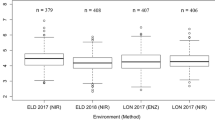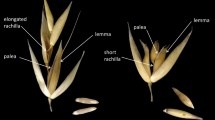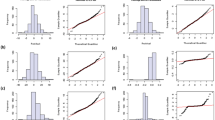Abstract
Detection of quantitative trait loci (QTL) controlling complex traits followed by selection has become a common approach for selection in crop plants. The QTL are most often identified by linkage mapping using experimental F2, backcross, advanced inbred, or doubled haploid families. An alternative approach for QTL detection are genome-wide association studies (GWAS) that use pre-existing lines such as those found in breeding programs. We explored the implementation of GWAS in oat (Avena sativa L.) to identify QTL affecting β-glucan concentration, a soluble dietary fiber with several human health benefits when consumed as a whole grain. A total of 431 lines of worldwide origin were tested over 2 years and genotyped using Diversity Array Technology (DArT) markers. A mixed model approach was used where both population structure fixed effects and pair-wise kinship random effects were included. Various mixed models that differed with respect to population structure and kinship were tested for their ability to control for false positives. As expected, given the level of population structure previously described in oat, population structure did not play a large role in controlling for false positives. Three independent markers were significantly associated with β-glucan concentration. Significant marker sequences were compared with rice and one of the three showed sequence homology to genes localized on rice chromosome seven adjacent to the CslF gene family, known to have β-glucan synthase function. Results indicate that GWAS in oat can be a successful option for QTL detection, more so with future development of higher-density markers.






Similar content being viewed by others
References
Benjamini Y, Hochberg Y (1995) Controlling the false discovery rate: a practical and powerful approach to multiple testing. J Roy Stat Soc B 57:289–300
Braaten TJ, Wood PJ, Scott FW, Wolynetz MS, Lowe MK, Bradley-Whyte P (1994) Oat β-glucan reduces blood cholesterol concentration in hypercholesterolemic subjects. Eur J Clin Nutr 48:465–474
Bradbury P, Parker T, Hamblin MT, Jannink J-L (2011) Assessment of power and false discovery rate in genome-wide association studies using the barley CAP germplasm. Crop Sci 51:52–59
Burton RA, Fincher GB (2009) (1,3;1,4)-beta-d-glucans in cell walls of the Poaceae, lower plants, and fungi: a tale of two linkages. Mol Plant 2:873–882
Burton RA, Shirley NJ, King BJ, Harvey AG, Fincher GB (2004) The CesA gene family of barley. Quantitative analysis of transcripts reveals two groups of co-expressed genes. Plant Physiol 134:224–236
Burton RA, Wilson SM, Hrmova M, Harvey AJ, Shirley NJ, Medhurst A, Stone BA, Newbigin EJ, Bacic A, Fincher GB (2006) Cellulose synthase-like CslF genes mediate the synthesis of cell wall (1,3;1,4)-β-d-glucans. Science 311:1940–1942
Burton RA, Jobling SA, Harvey AJ, Shirley NJ, Mather DE, Bacic A, Fincher GB (2008) The genetics and transcriptional profiles of the cellulose synthase-like HvCslF gene family in barley. Plant Physiol 146:1821–1833
Chernyshova AA, White PJ, Scott MP, Jannink J-L (2007) Selection for nutritional function and agronomic performance in oat. Crop Sci 47:2330–2339
Colleoni-Sirghie M, Fulton B, White PJ (2003) Structural features of water soluble (1–3), (1–4)-β-d-glucan from high-β-glucan and traditional oat lines. Carbohydr Polym 54:237–249
De Koeyer DL, Tinker NA, Wight CP, Deyl J, Burrows VD, O’Donoughue LS, Lybaert A, Molnar SJ, Armstrong KC, Fedak G, Wesenberg DM, Rossnagel BG, McElroy AR (2004) A molecular linkage map with associated QTLs from a hulless × covered spring oat population. Theor Appl Genet 108:1285–1298
Endelman JB (2011) Ridge regression and other kernels for genomic selection with R package rrBLUP. Plant Genome 4:250–255
Estrada A, Yun CH, Van Kessel A, Li B, Hauta S, Laarveld B (1997) Immunomodulatory activities of oat beta-glucan in vitro and in vivo. Microbiol Immunol 41:991–998
Fincher GB (2009) Exploring the evolution of (1,3;1,4)-β-d-glucans in plant cell walls: comparative genomics can help! Curr Opin Plant Biol 12:140–147
Hamblin MT, Close TJ, Bhat PR, Chao S, Kling JG, Abraham KJ, Blake T, Brooks WS, Cooper B, Griffey CA, Hayes PM, Hole DJ, Horsley RD, Obert DE, Smith KP, Ullrich SE, Muehlbauer GJ, Jannink J-L (2010) Population structure and linkage disequilibrium in U.S. barley germplasm: implications for association mapping. Crop Sci 50:556–566
Hill WG, Robertson A (1968) Linkage disequilibrium in finite populations. Theor Appl Genet 38:226–231
Izydorczyk MS, Macri LJ, Mac Gregor AW (1998) Structure and physiochemical properties of barley non-starch polysaccharides-I. water-extractable β-glucans and arabinoxylans. Carbohydr Polym 35:249–258
Jannink J-L, Bink MCAM, Jansen RC (2001) Using complex plant pedigrees to map valuable genes. Trends Plant Sci 6:337–342
Jenkins AL, Jenkins DJA, Zdravkovic U, Würsch P, Vuksan V (2002) Depression of the glycemic index by high levels of beta-glucan fiber in two functional foods tested in type 2 diabetes. Eur J Clin Nutr 56:622–628
Kang HM, Zaitlen NA, Wade CM, Kirby A, Heckerman D, Daly MJ, Eskin E (2008) Efficient control of population structure in model organism association mapping. Genetics 178:1709–1723
Kearsey MJ, Farquhar AGL (1998) QTL analysis in plants; where are they now? Heredity 80:137–142
Keenen JM, Pins JJ, Frazel C, Moran A, Turnquist L (2002) Oat ingestion reduces systolic and diastolic blood pressure in patients with mild or borderline hypertension: a pilot study. J Family Pract 51:369
Kennedy BW, Quinton M, van Arendonk JAM (1992) Estimation of effects of single genes on quantitative traits. J Anim Sci 70:2000–2012
Kianian SF, Phillips RL, Rines HW, Fulcher RG, Webster FH, Stuthman DD (2000) Quantitative trait loci influencing β-glucan content in oat (Avena sativa, 2n = 6x = 42). Theor Appl Genet 101:1039–1048
Lande R, Thompson R (1990) Efficiency of marker-assisted selection in the improvement of quantitative traits. Genetics 124:743–756
Miyagawa T, Nishida N, Ohashi J, Kimura R, Fugimoto A, Kawashima M, Koike A, Sasaki T, Tanii H, Otowa T, Momose Y, Nakahara Y, Gotch J, Okaxaki Y, Tsuji S, Tokunaga K (2008) Appropriate data cleaning methods for genome-wide association study. J Hum Genet 53:886–893
Newell MA, Cook D, Tinker NA, Jannink J-L (2011) Population structure and linkage disequilibrium in oat (Avena sativa L.): implications for genome-wide association studies. Theor Appl Genet 122:623–632
Newell MA, Kim HJ, Asoro FG, Lauter A, White PJ, Scott MP, Jannink J-L (2012) Micro-enzymatic evaluation of oat (Avena sativa L.) beta-glucan for high-throughput phenotyping. Cereal Chem. (in review)
Ouyang S, Zhu W, Hamilton J, Lin H, Campbell M, Childs K, Thibaud-Nissen F, Malek RL, Lee Y, Zheng L, Orvis J, Haas B, Wortman J, Buell CR (2007) The TIGR Rice Genome Annotation Resource: improvements and new features. Nucleic Acids Res 35:D883–D887
Robertson A (1960) A theory of limits in artificial selection. Proc Royal Soc London, Series B, Biological Sciences 153:234–249
R Development Core Team (2009) R: a language and environment for statistical computing. R Foundation for Statistical Computing, Vienna, Austria. ISBN 3-900051-07-0. URL http://www.R-project.org
SAS Institute (2010) SAS/STAT® 9.2 User’s Guide, SAS Campus Drive, Cary, North Carolina 27513
Stich B, Möhring J, Piepho H-P, Heckenberger M, Buckler ES, Melchinger AE (2008) Comparison of mixed-model approaches for association mapping. Genetics 178:1745–1754
Sun G, Zhu C, Kramer MH, Yang S-S, Song W, Piepho H-P, Yu J (2010) Variation explained in mixed-model association mapping. Heredity 105:333–340
Tinker NA, Kilian A, Wight CP, Heller-Uszynska K, Wenzl P, Rines HW, Bjørnstad Å, Howarth CJ, Jannink J-L, Anderson JM, Rossnagel BG, Stuthman DD, Sorrells ME, Jackson EW, Tuvesson S, Kolb RL, Olsson O, Federizzi LC, Carson ML, Ohm HW, Molnar SJ, Scoles GJ, Eckstein PE, Bonman JM, Ceplitis A, Langdon T (2009) New DArT markers for oat provide enhanced map coverage and global germplasm characterization. BMC Genomics 10:39
Wight CP, Tinker NA, Kianian SF, Sorrells ME, O’Donoughur LS, Hoffman DL, Groh S, Scoles GJ, Li CD, Webster FH, Phillips RL, Rines HW, Livingston SM, Armstrong KC, Fedak G, Molnar SJ (2003) A molecular marker map in ‘Kanota’ × ‘Ogle’ hexaploid oat (Avena spp.) enhanced by additional markers and a robust framework. Genome 46:28–47
Yang J, Benyamin B, McEvoy BP, Gordon S, Henders AK, Nyholt DR, Madden PA, Heath AC, Martin NG, Montgomery GW, Goddard ME, Visscher PM (2010) Common SNPs explain a large proportion of the heritability for human height. Nat Genet 42:565–569
Yu J, Pressoir G, Briggs WH, Bi IV, Yamasaki M, Doebley JF, McMullen MD, Gaut BS, Nielsen DM, Holland JB, Kresovich S, Buckler ES (2006) A unified mixed-model method for association mapping that accounts for multiple levels of relatedness. Nat Genet 38:203–208
Zhu C, Gore M, Buckler ES, Yu J (2008) Status and prospects of association mapping in plants. Plant Genome 1:5–20
Acknowledgments
Funding for this work was provided by USDA-NIFA grant number 2008-55301-18746 “Association genetics of beta-glucan metabolism to enhance oat germplasm for food and nutritional function”.
Author information
Authors and Affiliations
Corresponding author
Additional information
Communicated by I. Mackay.
Electronic supplementary material
Below is the link to the electronic supplementary material.
ESM 1. Information about all of the lines included in this study including the assigned numbers and data from GRIN for each line.
ESM 2. Final imputed marker data and beta-glucan BLUPs used for analysis with rows representing lines and columns representing markers.
ESM 3. List of rice candidates and significant DArT marker homology with rice including locations, putative functions of rice genes, and genomic regions of all sequences.
Rights and permissions
About this article
Cite this article
Newell, M.A., Asoro, F.G., Scott, M.P. et al. Genome-wide association study for oat (Avena sativa L.) beta-glucan concentration using germplasm of worldwide origin. Theor Appl Genet 125, 1687–1696 (2012). https://doi.org/10.1007/s00122-012-1945-0
Received:
Accepted:
Published:
Issue Date:
DOI: https://doi.org/10.1007/s00122-012-1945-0




